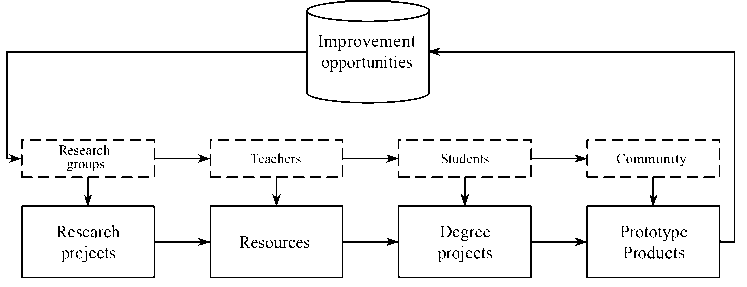
Ship Science & Technology - Vol. 16 - n.° 31 - (19-34) July 2022 - Cartagena (Colombia)
DOI: https://doi.org/10.25043/19098642.232
Bashir Yacub Bermúdez 1
Carlos A. Gutiérrez Martínez 2
Wilbhert A. Castro Celis 3
1 School of Naval Engineering, Escuela Naval de Cadetes "Almirante Padilla". Cartagena, Colombia. Email: bashir.bermúdez@enap.edu.co
2 School of Naval Engineering, Escuela Naval de Cadetes "Almirante Padilla". Cartagena, Colombia. Email: carlos.gutierrez@enap.edu.co
3 Departamento de Armas y Electrónica - Armada República de Colombia- ARC. Cartagena, Colombia. Email: wilbhert.castro@armada.mil.co
Date Received: February 24th, 2022 - Fecha de recepción: 24 de febrero de 2022
Date Accepted: July 15th, 2022 - Fecha de aceptación: 15 de julio de 2022
This paper presents the preliminary results of the implementation of a pedagogical-research strategy, oriented to the generation of capabilities in the development of Unmanned Surface Vehicles - USVs at the Naval Cadet School "Almirante Padilla", with the support of the Corporación de Ciencia y Tecnología para el Desarrollo de la Industria Naval, Marítima y Fluvial - COTECMAR. The strategy implemented is based on the linking of undergraduate students to research projects oriented by the Research Groups, under the guidance of the professor, who acts as a researcher and at the same time fosters the environment for cooperative and interdisciplinary work among the participating students. Three significant experiences are presented that show clear results in the development of USVs.
Key words: Pedagogical-investigative strategy, Unmanned Surface Vehicle, Project Ship, Project Sábalo, Hydrocontest.
El presente trabajo presenta los resultados preliminares de la implementación de una estrategia pedagógica-investigativa, orientada a la generación de capacidades en el desarrollo de Vehículos de Superficie No Tripulados - USVs en la Escuela Naval de Cadetes “Almirante Padilla”, con el apoyo de la Corporación de Ciencia y Tecnología para el Desarrollo de la Industria Naval, Marítima y Fluvial - COTECMAR. La estrategia implementada se fundamenta en la vinculación de estudiantes de pregrados a los proyectos de investigación orientados por los Grupos de Investigación, bajo la orientación del profesor, quien funge como investigador y a la vez propicia el ambiente para el trabajo cooperativo e interdisciplinario entre los estudiantes participantes. Se presentan tres experiencias significativas que demuestran claros resultados en el desarrollo de USVs.
Palabras claves: Estrategia pedagógica-investigativa, vehículos de superficie no tripulados, Proyecto Buque, Proyecto Sábalo, Hydrocontest.
Unmanned Surface Vehicles (USVs) are devices that travel on the surface of the water without submerging and can be operated from an office or programmed routes (Drone Spain, n.d., para. 5). They are widely used by different countries around the world for the development of maritime missions, mainly mine warfare and countermeasures (MCM), anti-submarine warfare (ASW), intelligence, surveillance and reconnaissance (ISR), maritime and port security, surface warfare (ASUW), support to special forces groups and electronic warfare (EW). At a national level and observing this wide spectrum of applications, we find that the naval industry does not present significant developments of USVs, being this a great opportunity for development due to the maritime potential it has.
In this way, the Colombian Navy, recognizing its fundamental role, assumes the leading role in promoting technological development in the country and enhancing the technological R&D&I capabilities of the naval sector. In this sense, the Navy intends to "migrate to operational scenarios of greater efficiency, from the introduction (acquisition or generation) and implementation of new technologies, promoting research within the institution and effectively articulating with its main technological development center, the Corporation of Science and Technology for the Development of the Naval, Maritime and Riverine Industry (COTECMAR), the research centers of the General Maritime Directorate (DIMAR), the other research centers, the academy and the industry" (National Navy, 2015, p. 42).
This fact has boosted the growth of the Colombian naval industry, mainly concentrated in COTECMAR, an entity belonging to the Colombian Navy - ARC, which has been working in this field of scientific and technological research, supporting the development of the maritime industry. Currently, COTECMAR dedicates its efforts to the advanced design, construction and maintenance of naval platforms (COCTEMAR, 2021). However, a first step for the start, sustainability and development of the USV production line has to do with strengthening the research capabilities of the sector's human resources, many of whom are Naval Officers trained at the "Almirante Padilla" Naval Cadet School (ENAP).
As a consequence, ENAP, as the alma mater of the National Navy Officers, carries out research projects in which students are involved through their degree projects, based on a pedagogical-research strategy, whose purpose is to deepen the knowledge delivered to its students, promoting the development of R+D+i capabilities and proposing methods that offer effective and versatile solutions to environmental problems, hand in hand with strategic allies such as COTECMAR, DIMAR, the Department of Weapons (DARET), universities and private industry; in such a way that this, as a whole, ends up being effectively articulated with ENAP's substantive functions. In this sense, this article presents the results of a significant experience, based on a pedagogical-research strategy implemented, called "Project Vessel" and the way it has promoted the generation of capabilities in the development of Unmanned Surface Vehicles at ENAP.
"ENAP is an institution that depends organizationally on the National Navy, focuses its function in a coherent and relevant way for the comprehensive training of Officers and Cadets of the National Navy, Merchant Navy and professionals in the maritime sector (...)" (ENAP, 2015). It has, among others, the faculties of Maritime Administration, Naval and Nautical Sciences, Physical Oceanography and the Faculty of Naval Engineering (FACIN). In turn, the Faculty of Naval Engineering develops the academic programs of Electronic Engineering and Naval Engineering, mission programs, created to meet the specific needs of the National Navy.
"The need for training at the professional level requires educational institutions to include innovative strategies in their academic offer with which competent professionals, capable of responding to market requirements, are profiled in each cohort" (M. F. Serrano Guzmán, N. C. Solarte Vanegas, 2015). This implies the adoption of a Pedagogical Model of learning that supports the teaching methodologies in which each academic program is offered. In the particular case of ENAP, the Institutional Pedagogical Model is based on a particular relationship between the aspects related to military and academic training, the directive authorities, the teacher-mediator, the military instruction and the student, within a characteristic context in accordance with the hierarchical institutional nature. "This pedagogical model focuses on the constructivist and cognitive-behavioral theoretical reference, which, are applicable to all programs as the main guide, without leaving aside the other methods that are complementary due to the humanistic and social components of the subjects" (ENAP, 2016).
Constructivist models conceive the teacher as a mediator between the experience of the environment and the processes of appropriation and construction of knowledge in students. Their role is to generate conditions, promoting the emergence of questions and interactions for meaningful, pertinent and structured learning. This requires qualified teachers, reflected in competence and willingness to provide support, transferring the domain of knowledge to the student in which autonomous learning and personalized accompaniment for academic activities are privileged.
The current role of engineering in the country requires the active participation of both public and private organizations that promote the generation of opportunities for the development of R&D&I activities from a scientific-technical perspective. Thus, ENAP has been strengthening its research and innovation culture, knowledge transfer, entrepreneurship and creativity. There is a whole research ecosystem formed by the Research Dean's Office (DIDEN), the Center for Innovation, Development and Research for Maritime Activities - CIDIAM, the different Academic Dean's Offices, the strategic allies (COTECMAR, DIMAR, DARET), among others. ENAP has created a model to strengthen the formative research process, in which three subjects are integrated in its first training cycle professional (Formative Research I, Formative Research II and Formative Research III) and two subjects (Project Management and Degree Work) in the Professional Complementation courses, thus promoting the formation of an investigative, creative and innovative spirit in the students.
On the other hand, the School of Naval Engineering, through the document "Guidelines for Formative Research", defines the criteria, strategies and activities of the program that promote the formation of a research, creative and innovative spirit in the students. This, in accordance with the policy of the National Navy, in which the degree project of the Naval Officers must be oriented to solve real problems of the Institution, has made the degree project one of the mechanisms that most contributes to the development of the substantive functions of the academic programs.
In response to the above and in compliance with the mission requirements of the Colombian Navy (Naval Officer Training), the Ministry of National Education "MEN" (Qualified Registration and High Quality Accreditation of the Program), the ENAP (Institutional Accreditation), the naval industry and society in general, the DFIN strategically aims to develop research projects, framed in the research lines of its Research Group in Naval Control, Communications and Design (GICCDN). This pedagogical-research strategy incorporates elements of the Project Based Learning (PBL) methodology, a strategy where the student is involved in the design, problem solving, decision making, or research activities; giving him/her the opportunity to work autonomously for a long period of time; and culminates in products or realistic presentations close to the professional world (Fernandez, 2006). In this way, students develop their degree projects from the solution to problems that arise from research projects.
The Naval Control, Communications and Design Research Group (GICCDN) is responsible for promoting research in the Faculty. Its research lines in the naval area (Research Line in Naval Architecture - Sub line "Design of ships, naval artifacts and unmanned vehicles") and in the electronic area (Research Line in Robotics and digitalization: 4.0 - "Platform control system" subline and Sensors, communications and simulation research line - "Communications development" sub-line), are integrated to generate projects oriented to the development of USVs. In this way, interdisciplinary and multidisciplinary work teams are formed, with the participation of Naval Engineering and Electronic Engineering students, teachers and researchers. The methodological process is shown in Fig. 1. In this way, formative research is enriched to the extent that it promotes observation and critical analysis to find solutions to environmental problems, with different approaches and tools. Thus, while formative research develops students' logical and creative thinking, project work puts thinking into action through practical applications such as prototypes, processes or systems and prepares students to understand how to conceive, design, implement and operate complex engineering systems based on participation in work teams (...), as Crawley (2001) points out.
Fig. 1. Methodological process of pedagogical-research strategy FACIN.
Source: Own elaboration, based on FACIN reference.
In this pedagogical-research strategy, from the constructivist theories, the teacher-researcher in his role of mediator proposes research or technological development projects in which students are involved. In this way, there is an interaction between the teacher and the students; the teacher in his role of supervisor, advisor, researcher and the students as executors of the project. The students' degree projects are then the appropriate academic space in which teachers, students, managers, researchers and entrepreneurs interact to propose solutions to real problems of the environment.
The following are three significant experiences developed under the pedagogical-research strategy presented.
The "Ship Project" was launched in 2016 by CF. Roberto Carlos Ángel as a research strategy, based on a research project funded by the National Navy of Colombia (ARC) focused on to the conceptual design of an instruction and training ship for the Naval Cadet School "Almirante Padilla". As an academic-research strategy, students develop their degree projects and strengthen their engineering competencies and strengthen the professional and occupational profile of the career.
The implementation of the strategy involves the use of methodologies specific to the discipline; in the case of naval engineers, it is based on naval design. Students learn knowledge about computational tools, handling of specialized software (Maxurf, CFD, Autocad, Rhino, Hydromax), apply the knowledge of the subjects of the study plan and generate research habits through the search for bibliographic information. For its part, the "Ship Project" is based on naval design, following the design spiral methodology ("Fig. 2"). "This is a cyclical and iterative methodology, where they establish and develop the concepts proposed in each phase of the project with the consideration that these concepts have a direct relationship with each other" (Bello, 2016). The design spiral is applied in all phases of the project. It starts with very general and unclear concepts of the conceptual design, which are determined and related in each of the phases of the project until reaching its center or detail design phase. That is why the project of a ship is characterized by being cyclical and also seeks as time progresses to develop a higher level of detail in each of the aspects it addresses, so it has some phases that are set as objectives that will lead to the realization of the design and construction of the vessel.
Fig. 2. Design spiral.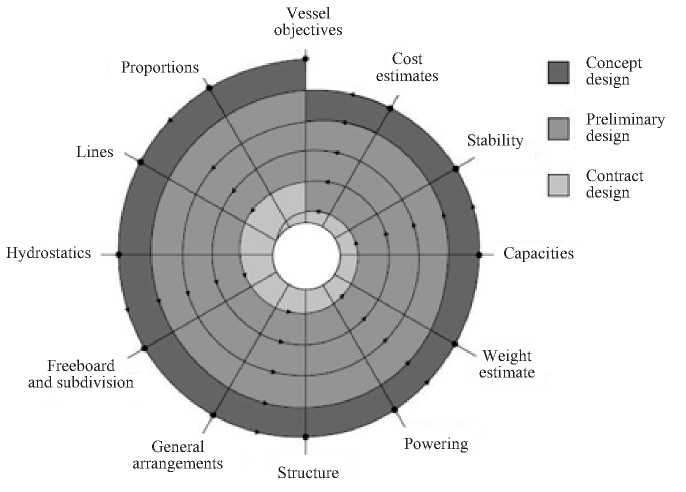
Source: (González, 2011).
The ship project follows a methodological and research process that is evidenced through the development of design booklets, as shown in Table 1. As a result, the hull design of prototype ships at different scales and specifications is obtained, which are the basis for the development of USVs and/or prototypes on which Colombian naval industry developments are based. Such is the case of the amphibious landing ship - BDA, which, as described in the Report of Science, Technology and Innovation Activities of COTECMAR, began as the product of a meritorious degree work of two ARC officers, entitled "Preliminary design of a landing ship type LCU for the ARC". This project is also a successful example of the UniversityCompany-State relationship (COTECMAR, 2014).
Table 1. Methodological and research process "Project Vessel".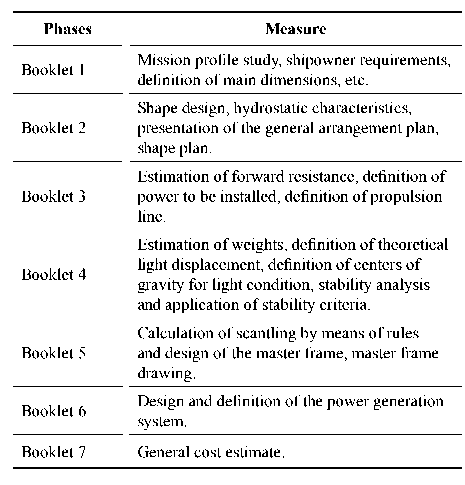
Source: FACIN
On the other hand, the Electronic Engineering students are the complement of the interdisciplinary approach. Following the methodology of technological development, with emphasis on the design of electronic systems ("Figure 3"), they develop the hardware essential for the functioning and operation of the USV. In this way, they design the navigation control systems, speed control, electrical power, propulsion, telemetry, sensors and wireless communications, essential for the command and remote control of the vehicle. In the same way, these students strengthen their knowledge in computational tools and handling of specialized software (Matlab, Labview, Proteus), applying the knowledge seen in the subjects of the study plan.
Fig. 3. System design process.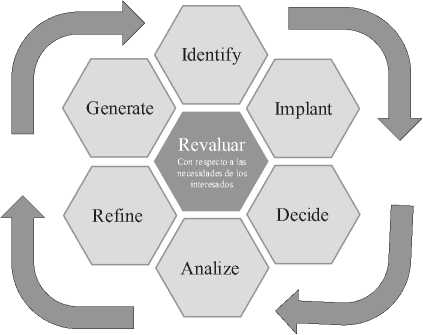
Source: Own elaboration based on (Burkhardt, 1996).
The "Hydrocontest Project" arises as a response to the challenge posed by the Hydrocontest International Competition, a competition organized annually by the Hydros Foundation. This Foundation is an accredited non-profit public interest foundation, whose objective is to promote technological innovation in response to the energy and environmental challenges facing the marine and maritime industry and to raise awareness of these issues among professionals, students, opinion leaders and the general public (Hydros Foundation, 2020). The competition has as its philosophy energy efficiency in naval vessels, offering three competition modalities (speed, distance and load capacity), in which students carry out their technological developments, research and innovations aimed at the design of boats that make more efficient use of energy. The competition has been held since 2014 and provides participants with the same electric propulsion motor and the same battery, as a source of energy, to meet the different challenges.
The "Hydrocontest Project" is conceived as a technological development, being the continuity at a more advanced level of the "Project Ship", using the same philosophy and methodology of naval and electronic design. In this case, it emphasizes the development of prototypes of highly energy efficient naval vessels, it has a scope ranging from the naval design of the USVs to the development of hardware and software, essential for the control and operation of the same from a shore station (Puello and Gutierrez, 2016). In this project, as an academic-research strategy, students develop their degree projects always with the accompaniment of research professors and advisors. This is aimed at multiple purposes, such as the development of energy-efficient USVs, strengthening teamwork, interdisciplinarity, institutional visibility, exchange of experiences, academic mobility and international interaction of students.
The development of USVs for the Hydrocontest competition started in 2016, with the design of two Trimaran type USVs (Trimaran with submerged bulb and Trimaran with inverted bow), with the hull shapes and characteristics for the Hydrocontest competition, as shown in Figs. 4 and 5. The project involved the design of the shapes, hydrostatic characteristics, presentation of the general arrangement plan and shape plan, estimation of the resistance to advance according to the power of the propulsion motor. Stability calculations were performed for a specific load (20 kg) in the light transport category and autonomy test, estimation of its behavior with respect to the estimation of weights and definition of centers of gravity were made (Bello, 2016).
Fig. 4. Hydrocontest 2016 participation strategy.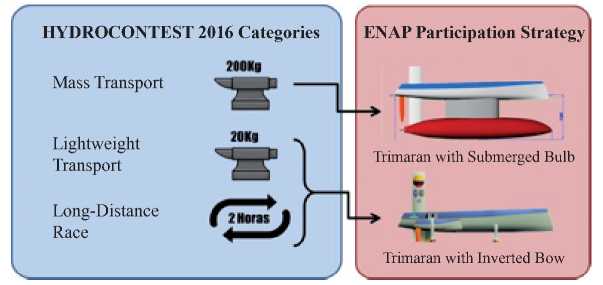
Source: (Gutiérrez, B. J. P. and Puello, O. M. 2016).
Fig. 5. Trimaran Hydrocontest competition.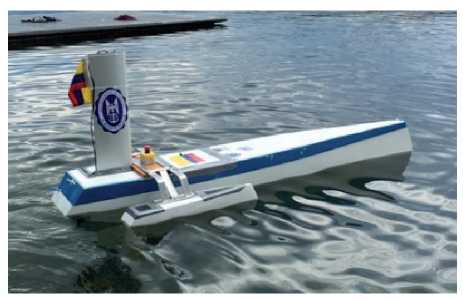
Source: (Gutiérrez, B. J. P. and Puello, O. M. 2016).
The design and modeling was done with Maxsurf, Rhinoceros and CFD software. In the electronic part, in charge of Electronic Engineering students from ENAP and Mechatronics Engineering students from the National University of Colombia, the steering and propulsion control was designed, consisting of a radio control system and sensors such as accelerometer, magnetometer, gyroscope, barometer and GPS. Likewise, telemetry systems were implemented to monitor battery parameters, a Binary Data Logger to store navigation data and a Human Machine Interface (HMI), where telemetry and navigation control data are displayed. See Fig. 6.
Fig. 6. General control diagram.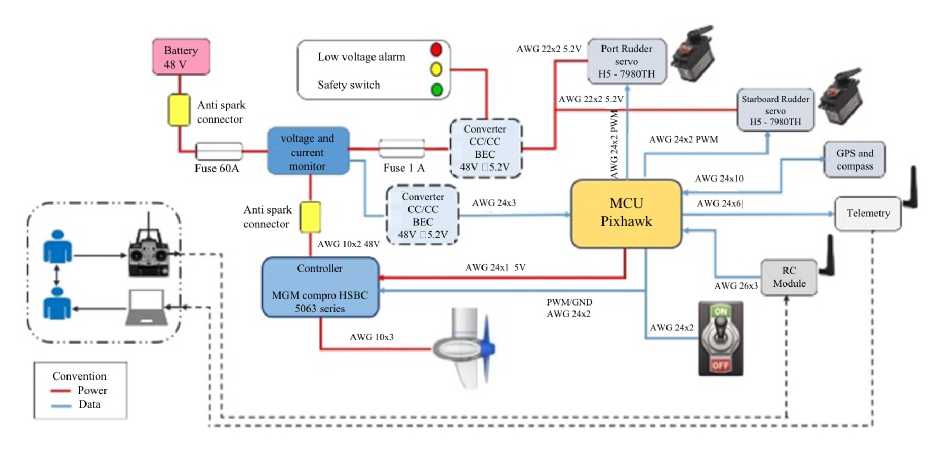
Source: Own elaboration taking as reference (Galvis & Pineda, 2016).
In subsequent developments of USVs, Catamaran type vehicles were designed with hydrofoils implementation, oriented to energy efficiency (Roa Almanza and Romero Lizcano, 2017; Riomaña and Polanía, 2018). These naval designs were carried out following the design spiral. Likewise, the corresponding calculations were performed through computational tools, obtaining an efficient and low-cost naval prototype that met the requirements of the competition. The design of these prototypes aimed at optimizing the shapes, use of composite materials, studies of resistance to the advance and implementation of appendages, thus improving the performance of the vessel. See Fig. 7.
Fig. 7. Hydrocontest Catamaran.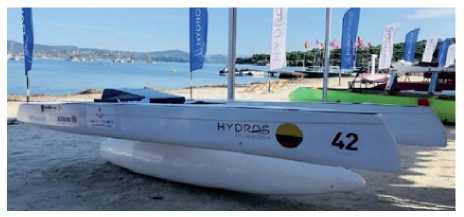
Source: (Riomaña and Polanía, 2018).
In the electronic part, improvements were introduced, such as the development of an artificial vision system with remote video transmission in real time, as an aid to the pilot's navigation; microcontrollers were integrated for the two-plane control of a video camera installed in the USV; development of the graphic interface for monitoring and visualization of telemetry signals of the battery status; in the same way, a video transmitter/ receiver was implemented for the visualization of the navigation environment, a radio data link (XBEE) for the wireless transmission of signals from an inertial sensor (IMU), which measures the orientation of the pilot's head (lateral and vertical movement); this in turn serves as a control signal for the camera. (Osorio and Nova, 2018).
The implementation of this strategy has brought together a work team made up of professors and students of Electronic and Naval Engineering from ENAP, students of Mechatronics Engineering from the National University of Colombia and advisors from COTECMAR.
This academic-research strategy has as its starting point the Proposal for Technology Transfer of the Autonomous Coastal Aquatic Search System "SABALO", 2013-2014, carried out by the Innova Group Organization of Spain, as a product of the offset between the National Navy and the company Otto Melara, for the development of the modernization project of the National Navy's Missile Frigates and the implementation of new technologies in the cannons on board. Basically, it involves the construction, technology transfer and delivery of 02 unmanned surface boats (see Fig. 8), equipped with various equipment (Microprocessor, navigation and surveillance cameras, Global Positioning System (GPS), Automatic Identification System (AIS), thermographic camera, among others) that allow it to develop operations in maritime and river environments (In-Nova, 2015).
Fig. 8. USV Sábalo.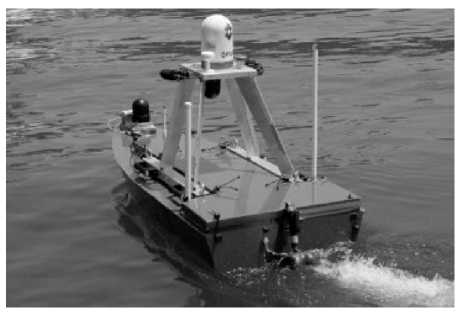
Source: Own elaboration.
The scopes defined for the Offset agreement became the starting point for the challenges faced by the National Navy to generate new capabilities to replace the existing software (owned by third parties) and to enable the specification and development of proprietary and national hardware components, allowing the reduction of foreign technological dependence on these technologies.
This project is considered as the methodological chaining and the technical-practical application of the strategies that began with the "Ship Project", which gathers all the experience accumulated in the "Hydrocontest Project"; likewise, the availability of technologies and sensors of the SABALO project, allow acquiring an important experience as a mobile laboratory for different generations of students of the Naval School, who, guided by the teaching staff, propose new developments to be executed with resources acquired through MINCIENCIAS-ARC calls for proposals. In this way, a technological development is obtained that has been evolving and improving the performance of the USV. Engineering students from ENAP, research professors from ENAP's GICCDN group in association with strategic allies such as the Research Group of the Naval Design and Engineering Program (PRODIN) of COTECMAR and the Research Group on Naval Engineering Technologies of the Naval School of Non-Commissioned Officers "ARC Barranquilla" (GITIN) have participated in this research project, which was born from the execution of research projects.
One of the projects formulated and executed to improve the technological development of the USV was entitled "Development of the Navigation Control System of the Unmanned Surface Vehicle "Sábalo" for its implementation in Maritime and River Patrol Operations", financed by MINCIENCIAS-ARC. Researchers from GICCDN and GITIN participated in this research proposal, oriented to the design and implementation of an autonomous navigation control system of their own, adjusted to the needs of the Colombian environment and the Colombian Navy. This project allowed the linkage of students through degree projects, in which the telemetry system for the monitoring of geographic position, roll, pitch, and magnetic orientation of the unmanned surface vehicle "Sábalo", IMU systems, GPS, in addition to the replacement of some technologies, achieving better control by the operator regarding the location and exact direction of the vehicle during navigation were developed (Camacho, 2017).
A second degree project implemented the wireless radio frequency control system for Pan-TiltZoom (PTZ) cameras in the UVS, which are used for obstacle avoidance and field of view enlargement during navigation. For this, they used radio transmitters and control codes from a Virtual Instrument (VI) developed in Labview, using the PELCO-D protocol (Amador and Correa, 2017). A third degree project obtained the mathematical velocity model of the USV Sábalo that was subsequently used for the design of the remote navigation control system. For this, it implemented an instrumentation system with an IMU measurement sensor (Buchheim, 2018). Likewise, Vargas and Canticus (2019) developed a photovoltaic-powered radio beacon for implementation in the USV Sábalo as an aid to the geolocation and recovery of the vehicle in situation of loss of the radio data link or battery discharges. The developed system is based on a network of electronic devices capable of processing and communicating by radio frequency its GPS position to be monitored in real time from the command console of the USV Sábalo. The device was integrated in the USV's bow compartment and can be activated automatically when it senses a sudden change in voltage or in the signal emitted by the system; when activated, the position of the USV will be known, a situation that makes salvage and location of the platform possible.
Another degree project related to the "Sábalo Project" was developed by Mejía and Impata (2020), who evaluated the performance of PI - PID controllers for the USV automatic speed control system, achieving a tuning that improved the USV operation in the remote control operation mode.
The development of this project with MINCIENCIAS-ARC made it possible to replace the navigation control system of the USV Sábalo with another processing core, with more robust components from National Instruments (Compact RIO). Compact RIO is an embedded industrial controller that operates in real time, oriented to industrial control and has reconfigurable I/O modules, FPGA module and an Ethernet expansion chassis, compatible with MyRIO boards and Labview software (National Instruments, 2020). This new system facilitates logic communication between devices, using TTL and UART transmitted signals and conversion between RS232 to RS-485 signal protocols and vice versa. This USV is capable of performing semi-autonomous remote control assisted navigation.
All actuators and sensors installed on the USV shad are listed in Tables 2 and 3.
Table 2. Actuators installed at USV Sábalo.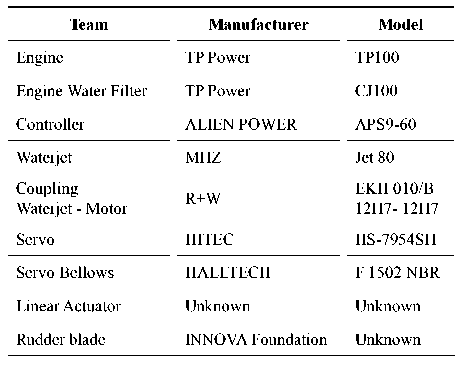
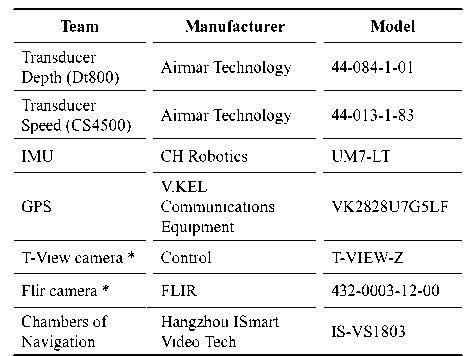
Currently, the "Sábalo Project" continues its course of evolution, scaling its level of technological development thanks to the financing approved by MINCIENCIAS-ARC, for the joint execution between COTECMAR and ENAP, of the project identified with code No. 75836 and entitled "Development of a technology demonstrator (TRL5) for the Unmanned Surface Vehicle for the Strategic Surface Platform (PES), focused on the communications system and its integration with the navigation control developed by ENAP for its future implementation in the USV of the PES".
This project is aimed at developing the communications system, the control station and the communications interface of the USV Sábalo with the naval tactical network of the ARC. For this purpose, we are working on the adaptation of a communications system that allows the transfer of control and telemetry data, as well as the transmission of video between the control station and the unmanned platform; likewise, a portable control station is being developed to allow the operation of the system from a remote location, incorporating new functions to the navigation algorithms.
The research groups of COTECMAR (PRODIN) and ENAP (GICCDN) participate in this project, as well as students of Electronic Engineering of ENAP.
Currently there is a related degree project, oriented to the tuning and performance evaluation of PI -PID controllers for the course control system of the USV "Sábalo".
Thus, the participation of students in this research project, guided by the faculty and researchers of COTECMAR and ENAP, is relevant to achieve the proposed objectives.
The strategy for obtaining capabilities is focused on the anthropic impact of the naval community within the shad model base that involves the participation of the STATE-UNIVERSITY-BUSINESS, where knowledge and decision making are strengthened under engineering criteria applied to design. In accordance with the above, the dialogue presented in the first instance between teachers/researchers and students is framed in developing competencies aimed at enabling students to learn on their own, be able to search for information, exercise critical thinking, pose and solve problems, work collaboratively, participate in networks and know how to communicate assertively (Lipman, 2006).
Taking into account the above and in an effort to contribute to the training of future research engineers to build learning communities, research development and capabilities for the solution of real problems of the industry and society in general, the School of Naval Engineering continues the strategy of involving students in research projects.
In this way, the participation of both the student community and the technological and scientific communities and the industry in general with whom we work is promoted, so that students, teachers and communities learn to respond creatively and collectively to their felt problems. (C. A. Torres Parra and J. Arias Hernández, 2015).
In order to contribute to the training of future researchers in the area of naval engineering and to strengthen the generation of new knowledge, this paper shows the main achievements of the strategy implemented for the development of USVs.
The research pedagogical strategy "Proyecto Buque" has been very prolific, achieving important results, as shown in Fig. 9.
Fig. 9. "Ship Project" products.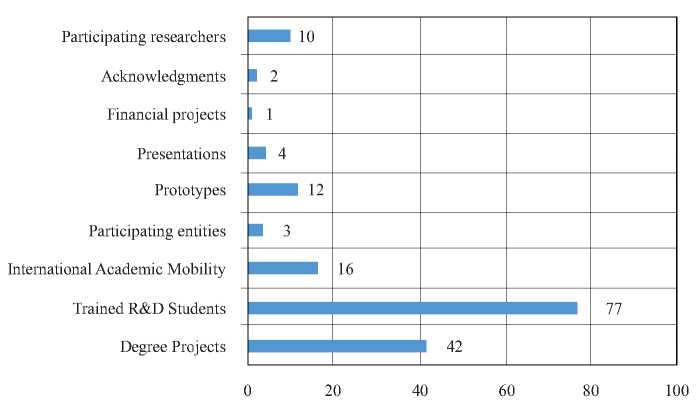
Source: Own elaboration.
As can be seen, the development of 42 degree projects, 77 students trained and experienced in R&D processes, the conceptual design of 25 vessels, the construction of 12 USV hull prototypes, 5 of which participated in international competitions, and the presentation of papers in national academic events are highlighted, pointing to the indicator of academic mobility of students and teachers.
It is worth mentioning that this project obtained funding from the ARC, involving 10 faculty members and achieving national recognition.
The pedagogical research strategy "Hydrocontest Project" made possible the visibility and international testing of the USVs developed by the group of participating students and teachers. The challenge of participating in a European competition (Lausanne - Switzerland, Saint-Trophez - France) with engineering students from all over the world, motivated the generation of better capacities for the development of USVs, which were evidenced in the evolution of the performance of these vehicles year after year. As shown in Fig. 10, we can highlight the development of 11 undergraduate projects, 20 students trained and experienced in R&D processes, as well as the construction of 5 USV hull prototypes (one Trimaran and two Catamaran for speed tests, and two monohulls for endurance and energy efficiency tests), attendance to 3 versions of the competition, 15 participating students, and a presentation at an international scientific event.
Fig. 10. "Hydrocontest Project". Products.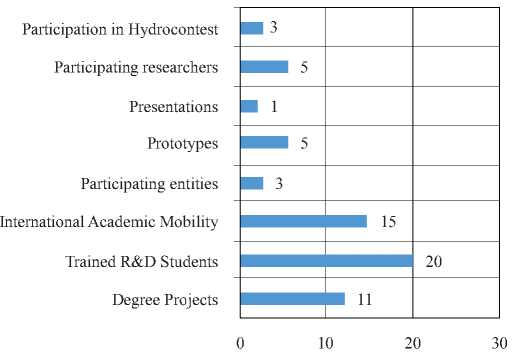
Source: Own elaboration.
At the institutional level, it contributed to the indicators of research, social projection, international visibility, academic mobility of students and teachers. Continuous participation in this competition has made possible the teamwork and interdisciplinary work between teachers and students of Electronic Engineering and Naval Engineering of ENAP, students of Mechatronics Engineering of the National University of Colombia, with the advice and scientific and technological support of COTECMAR.
Therefore, the "Project Ship" goes beyond participating in an international competition such as the Hydrocontest contest, but on the contrary, it aims to innovate and propose methods that offer effective and versatile solutions to the problem of cargo transportation, using existing electronic control systems, and innovating in the design of vessels and the use of composite materials for their construction. These solutions may be adopted and enhanced with strategic allies, effectively articulating as mentioned above with COTECMAR, DIMAR, universities and private industry; in such a way that this is just one more step in which the National Navy enhances research in the areas of knowledge allowing to contribute with actions aimed at national maritime development. (Puello and Gutierrez, 2016).
The "Sábalo Project", as a pedagogical-research strategy, represents the ideal of integration of the three substantive functions of research, teaching and social projection. As shown in Figure 11, the "Sábalo Project" obtained financing for the execution of two research projects from MINCIENCIAS-ARC, three participating institutions (ENAP, COTECMAR and the NCO School "ARC Barranquilla"), three Research Groups (GICCDN, GITIN and PRODIN), 12 students trained in R&D who developed 7 degree projects. Fifteen researchers have participated and so far have generated two publications, two national and one international paper, an industrial secret and the development of two prototypes.
Fig. 11. "Project Sábalo". Products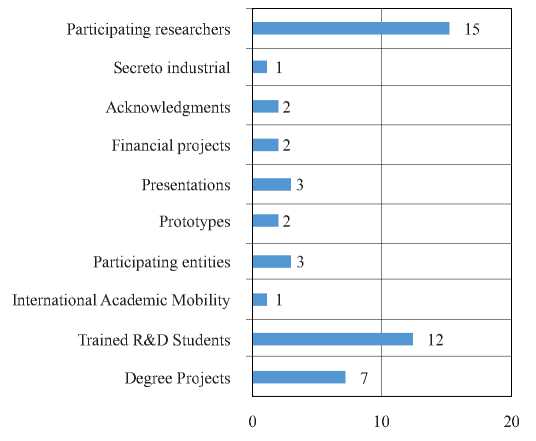
Source: Own elaboration.
The level of development achieved in the USV Sábalo has awakened the interest of educational entities and the National Navy itself to generate an advance in the technological independence of the institution, especially in this type of prototypes that are necessary in the complexity of the area of maritime and fluvial operations.
These experiences have strengthened an ecosystem and culture of research and innovation, knowledge transfer and creativity in which students have strengthened their research skills, appropriated tools and approaches from which problems are addressed; working with other disciplines, different entities and actors, reaffirms interdisciplinarity, promotes the strategic alliance university-business-state, achieving a positive interaction and financing of research projects. It also highlights the collaborative and cooperative work of its members. Recent studies show that teaching in small groups is effective and suggest that greater formative feedback from the teacher, more constant participation in small groups, or work that is more adjusted to the needs of the students, are factors that could explain this impact (SUMMA, 2019); it allows both the development of academic and professional competencies, as well as the development of interpersonal and communication skills.
The pedagogical-research strategy of linking within an ecosystem that combines the techniques of the business sector, the exploration and application of knowledge of the University and the social responsibility of developing solutions to the needs of the state, strengthen the training of students, providing the possibility of generating technological development projects, in this case, to the development of USVs that seek to provide solutions to real problems of their environment, taking advantage of the interdisciplinary management of topics that promote creativity, teamwork and innovation, while articulating with teaching, research and social projection, which are fundamental pillars of higher education.
The contribution to technological progress that has been expanded in each of the projects developed on ship hull designs, type of materials used, communications, telemetry, sensorics and autonomous navigation control systems for unmanned vehicles (USV), have allowed the management of knowledge in terms of systems integration, digitization, controllers and modulation of events for the different analyses in the field of Naval and Electronic Engineering, where it has awakened a great interest among students and the National Navy itself, interested in technological independence, especially in this type of vehicles, which are increasingly used in the complexity of maritime and river operations.
The project "Technological development of a technology demonstrator (TRL5) for the Unmanned Surface Vehicle for the Strategic Surface Platform (PES)" demonstrates the progress and maturity that is intended to be reached in the short term, in the development of this type of technologies, which has promoted teamwork and interdisciplinary work, the establishment of strategic alliances with common interests, between University-Company-State, the training of personnel in R&D and the appropriation of scientific, technological and industrial capabilities, of strategic interest for the country and the institution, which will have a positive impact on the Colombian naval industry.
The writing of this article was possible thanks to the joint participation of the Naval Cadet School "Almirante Padilla", COTECMAR, the Naval School of Warrant Officers "ARC Barranquilla" and the National Navy of Colombia, which through the Francisco José de Caldas Fund of MINCIENCIAS, is financing project 75836, whose initial phase of identification of requirements and state of the art, allowed the preparation of this article.
1. AMADOR, L., y CORREA, N. (2017). Implementación del sistema de control de cámaras PTZ por radiofrecuencia en vehículos de superficie no tripulados “SABALO”. [Proyecto de grado]. Cartagena: Escuela Naval de Cadetes "Almirante Padilla".
2. ÁNGEL, R. C. et al (2016). Proyecto Buque, Diseño Conceptual de un Buque de Instrucción y Entrenamiento para la Escuela Naval de Cadetes “Almirante Padilla”. ENAP-ARC.
3. ARMADA NACIONAL. (2015). Plan Estratégico Naval 2015-2018, [En línea]. Disponible en: https://www.armada.mil.co/sites/default/files/plan_estrategico_ naval_2015-2018.pdf, recuperado: 21 de Mayo de 2021.
4. BUCHHEIM, H. (2018). Obtención del modelo de velocidad para el vehículo de superficie no tripulado "Sábalo" y su futura utilización en el desarrollo del sistema de control de navegación de la embarcación. [Proyecto de grado]. Cartagena: Escuela Naval de Cadetes "Almirante Padilla".
5. BELLO RODRÍGUEZ, A. L. (2016). Construcción de una embarcación con un diseño innovador de la conservación de la eficiencia energética para la participación del concurso Hydrocontest. [Proyecto de grado]. Cartagena: Escuela Naval de Cadetes "Almirante Padilla".
6. CAMACHO, D. A. (2017). Desarrollo del sistema de telemetría para el monitoreo de posición geográfica, balanceo, cabeceo y orientación magnética en vehículos de superficie no tripulados “SABALO”. [Proyecto de grado]. Cartagena: Escuela Naval de Cadetes "Almirante Padilla".
7. TORRES PARRA, C. A. y ARIAS HERNÁNDEZ, J. (2015). Prospectiva estratégica del semillero de investigación en vivienda saludable para promover la educación de calidad en el estudiante de ingeniería civil, EIEI, jul. 2015.
8. COTECMAR (2014). Informe de actividades de ciencia, tecnología e innovación - ACTI 2014. Pág 12. [en línea]. Disponible en: https://www.cotecmar.com/sites/default/filesdescargas/ACTI_2014_0.pdf, recuperado: 29 de Mayo de 2021.
9. CRAWLEY, E., MALMQUIST, J., ÔSTLUND, S. y BRODEUR, D. (2007). Rethinking Engineering Education - The CDIO Approach, Springer, New York, pp. 286.
10. COTECMAR (2021). [En línea]. Disponible en: https://www.cotecmar.com/, recuperado: 29 de Junio de 2021
11. Drone Spain. (s.f.). ¿Qué es un USV o barco no tripulado?, [En línea]. Disponible en: https://dronespain.pro/usv-barco-no-tripulado/, recuperado: 29 de Mayo de 2021
12. ESCUELA NAVAL DE CADETES “ALMIRANTE PADILLA” (2016). Proyecto Educativo Institucional (PEI-2015-2019)
13. FERNÁNDEZ, A. (2006). Metodologías activas para la formación de competencias. Educatio siglo XXI, 24 · 2006, pp. 35 - 56
14. GALVIS, J. D., y PINEDA, J. F. (2016). Documento Técnico - Sistemas Eléctrico y de Control. Bogotá D.C.: Universidad Nacional de Colombia
15. GUTIÉRREZ, J. P. y PUELLO, O. M. (2016). Diseño e implementación de un sistema de control de gobierno y propulsión para un prototipo USV en el marco de la competencia internacional Hydrocontest en representación de la Escuela Naval de Cadetes “Almirante Padilla”. [Proyecto de grado]. Cartagena: Escuela Naval de Cadetes "Almirante Padilla".
16. GUTIÉRREZ, C., et al (2021). Speed and Heading Control System for an Unmanned Surface Vehicle - USV, inédito.
17. HYDROS FOUNDATION. (2021). Foundation. [en línea]. Disponible en: https://www.hydrocontest-x.ch/?page_ id=32&lang=en), recuperado: 22 de Mayo de 2021.
18. IN-NOVA, G. (2015). Manual de Integración USV SABALO.
19. ZAYAPRAGASSARAZAN, Z. y KUMAR, S. (2012). Active Learning Methods. NTTC Bulletin v19 n1 p3-5 2012. [en línea]. Disponible en: https://files.eric.ed.gov/fulltext/ED538497.pdf, recuperado: 24 de Mayo de 2021.
20. LIPMAN, M. (2006). À l’école de la pensée. Enseigner une pensée holistique. (2e édition). De Boeck Université.
21. MEJÍA J. R. y LARROTA C. A. (2017). Desarrollo de un sistema de visión remota para asistir el control manual de la navegación. Basado en un vehículo de superficie no tripulado (USV). [Proyecto de grado]. Cartagena: Escuela Naval de Cadetes "Almirante Padilla".
22. MEJÍA, A., Y IMPATÁ, N. (2020). Evaluación del desempeño de controladores PI - PID, para el sistema de control de velocidad del USV “SÁBALO”. [Proyecto de grado]. Cartagena: Escuela Naval de Cadetes "Almirante Padilla".
23. SERRANO, M. F. SOLARTE N. C., y TORRADO L.M. (2015). Políticas nacionales para apoyo de la investigación e innovación: un requisito para la formación de los profesionales del futuro, EIEI, jul. 2015.
24. NATIONAL INSTRUMENTS (2020). [en línea]. Disponible en: https://www.ni.com/es-co/shop/compactrio/what-are-compactrio-controllers.html , recuperado: 31 de Mayo de 2021
25. OSORIO, M. A. Y NOVA, J. A. (2018). Desarrollo de un sistema de telemetría capaz de medir y transmitir en tiempo real las variables de estado de la batería y los ángulos de navegación de una embarcación prototipo, para su monitoreo durante la participación en la competencia “Hydrocontest 2018”. [Proyecto de grado]. Cartagena: Escuela Naval de Cadetes "Almirante Padilla".
26. RIOMAÑA, C. A, Y POLANÍA, J. N. (2018). Diseño y construcción de una embarcación tipo catamarán con énfasis en la eficiencia energética: Caso concurso Internacional Hydrocontest 2018. [Proyecto de grado]. Cartagena: Escuela Naval de Cadetes "Almirante Padilla".
27. ROA, D. J. Y ROMERO, J. D. (2017). Diseño y construcción de una embarcación tipo catamarán con implementación de hydrofoils en el marco de la competencia internacional Hydrocontest 2017. [Proyecto de grado]. Cartagena: Escuela Naval de Cadetes "Almirante Padilla".
28. SUMMA (2019). Evidencia en América Latina, Enseñanza en grupos pequeños. [en línea]. Disponible en: https://www.summaedu.org/ensenanza-en-grupos-pequenos/ , recuperado: 15 de Julio de 2022.
29. VARGAS, J. D. Y CANTICUS H. M. (2019). Desarrollo de un radiofaro alimentado por paneles solares para su implementación en el USV Sábalo. [Proyecto de grado]. Cartagena: Escuela Naval de Cadetes "Almirante Padilla".